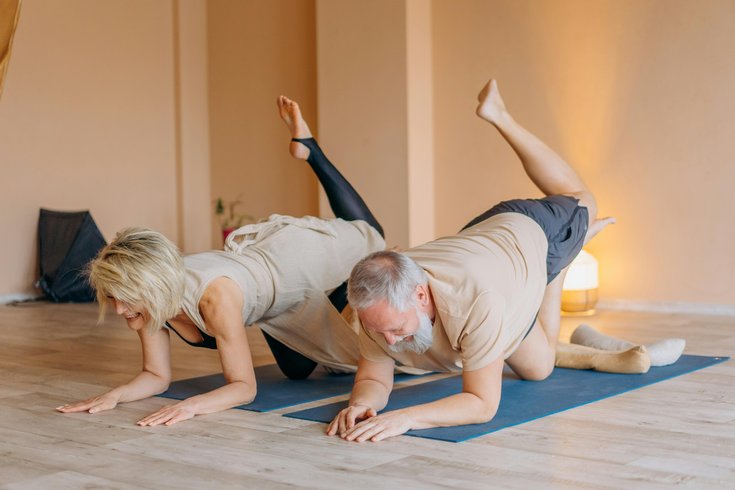
May 17, 2024
 Mikhail Nilov/Pexels.com
Mikhail Nilov/Pexels.com
Stretching has plenty of benefits. It can boost flexibility, reduce injury risk and improve posture.
If you're looking for a way to improve your flexibility, reduce stress, avoid injury and extend your range of motion to help boost your exercise performance, take a tip from Mother Nature: Stretch.
One of the best things we can do for our health, particularly as we age, is to stretch on a regular basis, at least two to three times per week according to the American College of Sports Medicine. Yes, Mother Nature gives us signals to healthy practices and Americans are recognizing them more than ever.
Ever notice your dog or cat arching their back when it wakes up? Do you start your day with a quick stretch as you get out of bed?
Stretching is a practice built into the body's reward system to make you feel better by increasing blood flow to your muscles and getting them more oxygen. Scientists call this the activation of the parasympathetic nervous system, which controls the body's ability to relax and maintain daily functions, processes known as "rest and digest." Some believe that stretching may release endorphins that can help reduce pain and boost your mood.
Today, stretching is booming across the U.S. According to ClassPass, a platform for the wellness industry, Pilates and yoga (two forms of stretching) ranked Nos. 1 and 2, respectively, in the top 10 most popular workouts last year. Reservations for Pilates bookings were up by 92%. And CNN reports that stretching studios are opening at rapid rates across the U.S. and that stretching is finding its way into American culture – as evidenced by the expansion of stretching areas in many gyms.
Stretching comes in many forms, so the details are important to understanding your options and some of the mixed messages from the medical community about the benefits of stretching. Stretch studio operator Stretch Zone explains the differences between yoga, Pilates and assisted stretching, but notes that all three produce similar benefits including improved flexibility, reduced injury risk and improved posture. They're also relaxing and energizing.
Stretch Zone, which operates nearly 400 studios in North America, says that yoga prepares the mind and body for meditation, Pilates focuses on body conditioning, and assisted stretching helps create and maintain functional flexibility. The experts at ClassPass suggest that you need not choose between stretch techniques and encourage a combination of approaches to maximize benefits and enhance other physical activities.
Finally, it is important to note a fourth alternative – stretching on your own. Though there are studios and professionals that can assist and offer classes, you can certainly pursue any of them on your own.
As is often the case within the medical community, there is not unanimous consent on the benefits of stretching, although the pushback seems to be centered on the preference to see people prioritize traditional strength-training and aerobic activities because of the association between disease and inactivity, and the limited time that people have for physical activity.
In a 2022 publication, Harvard Medical School's Dr. Adam Tenforde acknowledges that stretching may be important for dancers and athletes who need to maintain range of motion. But he adds that "if your focus is on improving your overall health, the evidence to support stretching is sorely lacking – especially compared with the wealth of evidence supporting the benefits of regular, moderate physical activity." Highlighting the fact that most Americans don't meet federal guidelines for physical activity, Tenforde points out the challenges to physicians, saying "as doctors, we're dealing more with diseases related to inactivity, not diseases of inflexibility."
Still, there is substantial support for stretching in the medical community, including others from Harvard. Another Harvard Medical School publication from 2022 suggests that stretching is important, particularly as you age, because joints become less flexible and impact daily activities like walking or turning your head to back up the car. They recommend regular stretching. And a report this year from Harvard Medical School says it's not enough to build muscle and achieve aerobic fitness, but that people need to think about flexibility – and that stretching can help. Other major health systems echo these sentiments.
While acknowledging the mixed results on stretching studies, The Mayo Clinic says research has shown stretching can help improve flexibility. It also can improve the range of joint motion, which can boost performance in physical activities, decrease risk of injuries and improve your ability to do daily activities.
The Cleveland Clinic says Pilates can improve muscle tone, flexibility and strength. They also can help people heal from their injuries. Yoga can decrease stress, reduce chronic pain, enhance the immune system's responses, lower blood pressure, improve posture and body alignment, increase muscle strength and provide a sense of joy and well-being.
So, if you're a 50-plus guy looking to maximize your fitness habits or hoping to improve your quality of life by boosting your flexibility, the experts at Texas Health offer recommendations for stretching your hamstrings, the most incorrectly stretched muscles. Before and after a workout, they suggest doing static stretches in which you hold a position for 30 seconds and repeat it three to five times before moving on to the next stretch. These static stretches include the bent knee stretch, seated stretch, standing hamstring stretch and lying hamstring stretch.
Another recommendation, dynamic stretching, involves slowly swinging the leg forward and backward, getting higher with each swing. Ten to 15 swings for each leg should suffice. Whether you chose static or dynamic stretching, the experts say you should avoid bouncing and never force any stretch.
I'm a big believer in stretching. It is a regular part of my daily workouts, both before and after my aerobic and weight-training sessions. Static stretching is my go-to, but I include dynamic moves for my shoulders and torso, and I sprinkle in a Pilates plank for my abdominal muscles.
For me, it initially came intuitively. As a baseball infielder in high school and college, bending and stretching was imbedded in my athletic psyche. Little did I know that I'd still be applying those same moves well into my 60s!
As always, what works for you and keeps you active is what's best. Go slow, talk to your doctor and, if you're inclined, maybe even try a stretch studio. If you get moving the rest will fall into place. Take a cue from Mother Nature and have a good stretch.